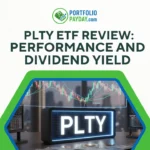Disclaimer: The following is for informational purposes only and not financial advice. Always do your own due diligence. I am not a licensed financial advisor
SPYI vs JEPI: Which Dividend ETF Is Better for Passive Income and Retirement Growth?
If you’re the kind of investor that I am, you’re probably always searching for the best dividend ETFs to build reliable passive income and long-term retirement wealth. So at this point, you’ve most likely found these two funds that stand out at the top of the pack: JEPI (JPMorgan Equity Premium Income ETF) and SPYI (NEOS S&P 500 High Income ETF). Both ETFs are highly popular among investors who want high dividend yields, monthly dividend payments, and exposure to the S&P 500.
In this blog post, we’ll explore JEPI vs. SPYI in detail, comparing their performance, dividend strategies, and suitability for different types of investors. We’ll also discuss why dividend investing is one of the most effective ways to build passive income streams and retirement income portfolios.
Why Dividend Investing is the Foundation of Passive Income
Have you ever wondered what it would feel like to receive money every month without having to lift a finger? That’s the power of dividend investing. By holding shares of dividend-paying stocks or ETFs like JEPI or SPYI, you can receive regular cash distributions, often paid monthly or quarterly.
Dividend ETFs are especially powerful because they combine diversification with income generation. Instead of betting on a single stock, you’re investing in a portfolio of companies that consistently pay dividends. For retirees or those seeking financial independence, this approach provides reliable income while reducing the need to sell shares during market downturns.
Would you rather sell off your portfolio piece by piece in retirement or let it pay you month after month? That’s the difference a strong dividend ETF strategy can make.
What Makes JEPI and SPYI Unique?
Both JEPI and SPYI stand out among the top monthly dividend ETFs because they combine exposure to the S&P 500 index with covered call strategies to boost yields. Here’s a quick breakdown of their features:
JEPI (JPMorgan Equity Premium Income ETF)
- Dividend Yield: Around 7-9%, depending on market conditions. As of August 2025, it’s 8.38%.
- Strategy: Focuses on high-quality, low-volatility stocks and sells covered calls to generate additional income.
- Payout Frequency: Monthly dividends.
- Best For: Investors who want steady monthly income with lower risk and reduced volatility. Think retirees.
SPYI (NEOS S&P 500 High Income ETF)
- Dividend Yield: Roughly 12% as of August 2025.
- Strategy: Tracks the S&P 500 while using a slightly more aggressive options overlay strategy for higher yield.
- Payout Frequency: Monthly dividends.
- Best For: Investors seeking maximum income and willing to accept slightly more market volatility.
SPYI vs JEPI: Key Differences
Both ETFs provide high-yield monthly income, but their strategies and risk levels differ.
- Dividend Yield and Income Potential
- SPYI dividend yield is typically higher (around 12%) compared to JEPI dividend yield (7-9%). If your goal is the highest monthly cash flow, SPYI might look more appealing.
- JEPI focuses on a more balanced approach, aiming for income stability and less downside risk.
- Underlying Holdings
- JEPI ETF doesn’t hold the full S&P 500. Instead, it selects low-volatility, high-quality stocks to protect against market drops.
- SPYI ETF mirrors the S&P 500 index more closely, which means greater exposure to both its gains and losses.
- Volatility vs. Yield Trade-off
- JEPI is a good fit for retirement portfolios or investors who prefer consistent monthly income with less risk.
- SPYI is better suited for aggressive income investors who prioritize higher dividend payouts over volatility concerns.
Why Dividend ETFs Like JEPI and SPYI Are Great for Retirement
Dividend ETFs for retirement income are a cornerstone of many wealth-building strategies. Unlike growth stocks that may require you to sell shares for cash, high-yield ETFs such as JEPI and SPYI let you live off the dividends while your principal continues to grow. This is the main reason why I invest heavily in dividend ETFs and stocks as I want my principal amount to stay relatively steady or continue to grow while producing income regularly.
Reinvesting dividends during your accumulation years creates a powerful compounding effect which is called the snowball effect. Imagine starting with $10,000 in JEPI and reinvesting all dividends for 10 years. The combination of dividend reinvestment plans (DRIP) and monthly payouts can turn your portfolio into a reliable cash machine.
What would happen if you started reinvesting today? In 10 or 20 years, the income growth from ETFs like JEPI and SPYI could fund a large portion of your retirement expenses.
Long-Term Dividend Growth Potential
Dividend investing is not just about today’s yield. It’s about building future income. Both JEPI and SPYI have shown they can provide steady distributions, and as covered call ETFs, they are designed to maintain consistent payouts even in volatile markets.
Over decades, reinvesting dividends from high-yield ETFs can lead to an exponential increase in income. That’s why many investors see these ETFs as a set-it-and-forget-it strategy.
Which is Better for Your Portfolio: JEPI or SPYI?
The answer depends on your investment goals and risk tolerance:
- Choose JEPI ETF if: You prefer a more conservative dividend ETF with lower volatility and steady monthly income.
- Choose SPYI ETF if: You want the highest monthly dividend payments and are comfortable with slightly higher risk.
Some investors even hold both JEPI and SPYI to diversify income sources. Could combining these ETFs create a more balanced income portfolio? Absolutely.
The Human Side of Dividend Investing
I’ll admit, discovering dividend investing completely changed how I view my finances. Instead of stressing over market swings, I now focus on how much passive income my ETFs generate each month.
What would it feel like to see $500 or $1,000 in monthly dividends deposited into your account? With ETFs like JEPI and SPYI, that goal is more achievable than you might think.
Building Passive Income with JEPI and SPYI
If you want to create financial freedom through passive income, both JEPI and SPYI are excellent choices for 2025 and beyond.
- JEPI is ideal for those who want stability and lower volatility.
- SPYI is perfect for those who want higher monthly dividends and can handle a more aggressive income strategy.
Dividend investing is not a quick path to wealth, but it is one of the most reliable ways to grow retirement income portfolios over time. The sooner you start, the stronger your compounding effect will be.



![Is SCHD Dead Weight — Or the Ultimate Dividend Machine? [2025 Guide]](https://portfoliopayday.com/wp-content/uploads/2025/08/SCHD-Thumbnail-150x150.png)









[…] SPYI is better for preserving capital while still generating income. Great for the distribution phase of retirement. […]